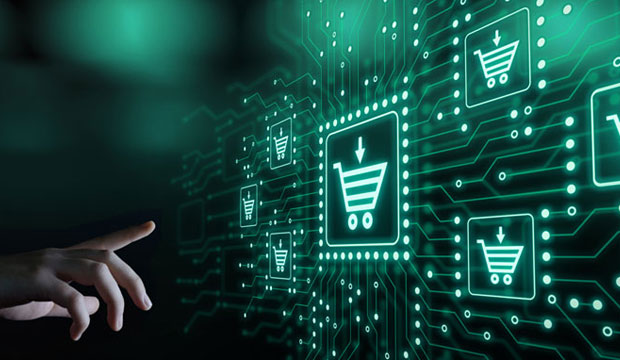Year over year, we see the numbers. In 2017, e-commerce represented 49 percent of all total retail growth, up 16 percent from the previous year.
If this year’s US$119.99 billion holiday shopping season spend indicates anything, it’s that 2018 is projected to be yet another banner year for commerce.
It’s hard to predict exactly what’s going to happen next, but I’m going out on a limb here and predicting that in 2019, online shopping will hit unprecedented, never-before-seen rates of growth, and it’ll be all thanks to technology.

We live in an exciting time when innovation is redefining what it means to be a retailer, what it means to be a shopper, and just what the heck that “e” in e-commerce even stands for anymore. That’s because modern consumers are shopping across a sea of touchpoints — researching online and purchasing offline; browsing in store, on mobile, then buying online — that are blurring the line between brick-and-mortar and digital. In order to succeed, retailers must adapt to these purchasing behaviors — and fast.
If you’re looking to kick 2019 off with a bang, you’ll want to take a look at how some of today’s most forward-thinking retailers have been integrating mobile, desktop, and in-store technology to provide the best experience for their customers. I’m predicting that more and more players will be paying attention to these features in the new year. Following are four retail tech trends you’ll want to be on the lookout for in 2019:
1. Real-Time Inventory Management Will Define Omnichannel
Omnichannel isn’t a new concept by any means, but this year it’s going to hit its stride. As interest in the multichannel shopping experience has grown, customers have been adapting with a bevy of new purchasing behaviors that utilize the convenience of both online and offline channels.
Top retailers have addressed these changes by offering more omnichannel options, such as Buy Online, Pick-up In Store (BOPIS) or Buy Online, Return In Store (BORIS).
Implementing these features can be a challenge, however, if you haven’t fully integrated your online and offline operations. In order to pull off an omnichannel strategy, your supply chain, orders, fulfillment and inventory systems *must* be synced completely and in conversation with each other.
Take, for example, inventory management in real time. Without a single source of truth for inventory, your website, marketplace, and brick-and-mortar sales channels are completely isolated from each other. This means that an item could be out of stock in one channel, yet readily in stock in another. If there’s a SKU in one channel that’s not synced with the other, retail associates won’t be able to access purchase data or process cross-channel returns.
Real-time inventory integration across channels allows retailers to provide their customers with a true, best-in-class omnichannel experience, one that accurately reflects the way people actually shop today.
In the new year, more retailers will be investing in a management solution that will allow them to connect across touchpoints in real time. After all, we live in a world where e-commerce is just, well, commerce.
2. Open Source Is Coming to Retail
Major brands like Walmart have jumped on this already, but in 2019, we anticipate that more retailers will follow suit. That’s because open source software offers two major advantages: 1) it’s highly customizable; and 2) there’s no vendor lock-in.
Because users have access to the entire codebase, they can pretty much do anything they want to the front end or back end of their online stores. Want to switch out a credit card payment module with a custom ledger instead? Want to turn your online store into an online marketplace? Done and done.
Because retailers own their data, code and intellectual property, it means that their business’ future isn’t tied to the limitations of a proprietary system. Open source systems offer the same level of ownership and customizability as a homegrown one, rendering the age-old buy vs. build dilemma moot.
Open source also addresses the retail industry’s talent gap. So much of traditional e-commerce is built on closed legacy systems and outdated tech stacks. It’s no wonder non-digitally native brands find it hard to attract and retain leading developer talent.
In 2019, expect to see more and more retailers adopting modern technologies such as JavaScript, Node.js, React, and Docker, contributing back to the worldwide open source community, and adding to its ever-expanding ecosystem.
3. Brick-and-Mortar Stores Will Start Experimenting With VR, AI and Robots – Oh My!
By 2025, the market for augmented reality (AR) and virtual reality (VR) retail is projected to reach $1.6 billion, according to Business Insider.
The singularity, however, is already near. At innovative tech giants like Sephora and L’Oreal, AR apps allow users to test out the look and feel of makeup right from the convenience of their smartphones. At stores like Topshop and Uniqlo, AR allows shoppers to change the color of the outfits they’re trying on, or to try out related products.
In the VR realm, Macy’s is slated to expand its VR furniture pilot program to 90 stores by January 2018, while Walmart will be adding 17,000 headsets to its stores for employee training programs.
So far, VR has provided retailers an immersive way to showcase experiences that require a new environment, such as sitting behind the wheel of a car.
Though it may seem as if commerce soon may become sentient, think again. Truthfully, many executions of AR and VR won’t last beyond the moment. Yes, AR and VR can enhance the shopping experience in a fun and novel way, but how do they add value for customers? Does facial recognition technology really benefit customers, or does it just plain creep them out?
If you’re interested in integrating AR and VR in the new year, you’ll want to make sure each new piece of technology comes with a strategic purpose. For instance, many customers have expressed interest in a retailer offering more utilitarian automation tools, such as automated returns and location-based mobile coupons.
4. Mobile and Self-Checkout Will Become Mainstream
We all know the golden rules of retail: The faster the checkout process, the happier the customer, the better the business results. In 2019, I’m predicting that mobile checkout, mobile self-checkout, and any alternative checkout feature that might speed up the point of purchase in store, will be the next big thing in retail.
It wasn’t so long ago that Apple pioneered mobile payments, but it sure has come a long way since then. In 2018 alone, major retailers like Target, Walmart, Nordstrom’s, Macy’s, Dollar General, and Home Depot introduced mobile checkout to their retail locations.
Some brands opted for mobile checkout, with roaming sales associates using their smartphones to scan items, and customers paying for them on the spot. Others tested mobile self-checkout, with customers downloading a retail app and scanning item labels themselves, all without ever having to approach a sales associate.
Both in-store options replicate the quick and easy checkout experience that shoppers now know and expect when buy online on a mobile or other device. With mobile payments, customers now can check out quickly in a store without having to deal with long lines, manual scanner snafus, or payment processing issues.
Prepare for the Future
In today’s fast-paced world of retail, competition is fierce. Since e-commerce and commerce have become so increasingly entwined, it’s not enough to focus on a single sales channel. Retailers that truly stand out from the rest prioritize continuous innovation, which allows them to anticipate the expectations of increasingly savvy shoppers.
With so many players in every industry, you’ll want to make sure your business offers the best in convenience, flexibility, personalization and service. It’s not just that the customer is always right — the customer also decides who sinks or swims.
The beginning of a new year is always a great time for reflection and planning. What were some of the pain points of your operations last year, and how might they be resolved in the new year? As more and more new technology solutions develop, you’ll want to focus on building a business that sustains itself for many years to come.
In 2019, make new retail technology an integral part of your business strategy. Your future self will thank you.


















































Social Media
See all Social Media